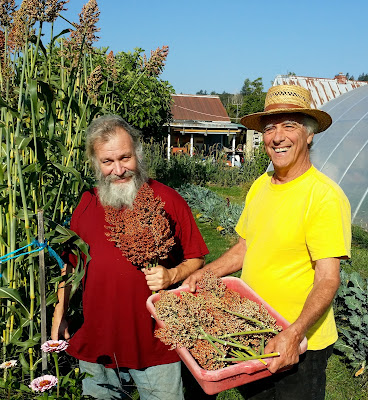...a shifting focus on what foods we grow...
(This is a re-post from January 2023 which explains the changes we made this year in the varieties of foods we grew, and why). Over the last few years, we've noticed that our donations of fresh vegetables have been less needed by the food charities we serve (see:
News from the Gardens Jan. 2023).
While we celebrate the abundance of produce being provided to our food-insecure neighbors through other channels, it has caused us at the Sharing Gardens to make some shifts in which crops we wish to emphasize and how best to use our garden space and the volunteer help provided by our share-givers.
In addition to the staple annual crops (tomatoes, cucumbers, lettuce, cabbage etc) that were shared amongst the share-givers (volunteers), in 2021 and 2022, we began dedicating a higher percentage of our garden space to corn, sorghum, beans and winter storage squash.
 |
Sandra harvests sweet, yellow Bantam corn which we dry and use for cereal and baking.
|
 |
Rook harvests Ba Ye Ki sorghum, a fast growing variety. Not as sweet as Kassaby but is better for shorter growing seasons (we had a cool, wet spring). (Cindy harvests broccoli on the right. The yellow flowers are broccoli purposely going to seed which we saved to replant and share with other gardeners.)
|
 |
Rook and Chris with sorghum harvest.
|
 |
Giant Greek white runner beans (on left tipi) in front of our largest greenhouse, the Sunship. (Scarlet Runner beans and this white variety easily cross).
|
 |
We always grow a long wall of runner beans inside the Sunship too. Here they are at the end of the season, turning brown (best to harvest them as dry as possible for better ripeness and storage. (Grow Your Own Protein - Scarlet Runner Beans)
|
 |
Jewells and Jenny harvesting runner beans.
|
The grain and bean crops are all hand-processed with the help of our share-givers. Shelling the beans, husking and shucking the corn and removing the sorghum seeds from their stalks are all coveted tasks in the autumn as share-givers sit around in the shade of our garden-shed-awning or, on cooler days, circle the cozy wood-stove in our Sunship greenhouse. These hand-tasks can be very relaxing and satisfying and even fun to do as a group and yet would be daunting and time-consuming for a solo farmer or farm-family.
 |
Chris and Donn, shelling runner beans
|
 |
We grow kidney beans as a bush-variety. Once ripe, these are cut off at ground level, leaving the roots in the ground (less mess and the worms like the dead roots) and laid on a tarp to dry.
|
 |
Chris and Jim threshing kidney beans on a tarp. After the beans are good and dry, we thresh them with wooden broom sticks or other tool-handles. This shatters most of the pods and the beans fall out onto the tarp. Some beans must still be shelled by hand and then they're winnowed in the wind.
|
We grind the dried grains in our Diamant grain mill which Chris hooked up to a re-purposed electric motor. We then mix the grains together to make a delicious and nutritious hot cereal, or use them in a baking mix for corn cake (LINK - Crumb-Free, Whole-Grain Cornbread Recipe ). The Hooker's blue corn we grow has been found to have 30% more protein than regular corn (LINK - Grow Your Own 'Blue Corn' ) and is sweet and hearty!
 |
Blue Hooker's corn, dried, husked and shucked. Ready for grinding.
|
 |
Our motorized grain mill.
|
 |
Bantam, blue corn, sorghum and polenta in our pantry. All grown at the Sharing Gardens!
|
 |
35 pounds of scarlet runner beans in 2022!
|
We continue to expand the amount of land we dedicate to winter squash too. Our winter squash harvest was excellent this year. We grew Delicatas and Sweet Meats (both delicious, moist varieties). We had enough to share with our share-givers to get them through the winter, with plenty of surplus for the S. Benton Food Pantry and the Stone Soup Kitchen.
 |
Just a fraction of this year's Delicata and Sweetmeat squash harvest. Yum!
|
So, the gardens are morphing from their original emphasis on providing food for food charities to a model which provides a significant amount of food to those who are helping to actually grow it. While at first we were concerned by this shift, we now see it as a natural progression and are happy that the food charities are so well stocked during the summer months of peak garden production and that the share-givers are SO appreciative of receiving the Garden's highest quality produce. This new trend frees the Sharing Gardens to continue to demonstrate a model that builds community using local resources for fertility while encouraging mutual generosity. (For info on other community-supporting projects we've already implemented, or intend to cultivate in the future, see: A Wintery Summary).
 |
We'll always have room for the brassicas: Donn and Chris prep beds for cabbage , collards and broccoli.
|

















